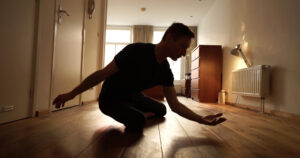
Opera Meets Film: Peter Sellars’ ‘this body is so impermanent’
By Katelyn SimonePeter Sellars warned the crowd gathered in the Rubin Museum on a recent Friday night that the film would be long. “It’s only an hour and fifteen minutes,” he said. “But the beginning feels like several lifetimes.”
At first, the caution was unnecessary. “this body is so impermanent,” a new film Sellars directed at the height of the pandemic, explores health and illness through the “Vimalakirta Sutra,” a foundational Buddhist text. Opening in a rush of sensation, “this body” stirs the senses with scenes of nature, water gushing over rocks, and raven-black calligraphy ink scraped in a bowl, with a fast cut to a delightfully hexagonal, sunlit window. A man lays in bed but quietly.
Near the 20-minute mark, though, novelty sinks into the glacial reality of the topic of sickness. The man squirms with malaise, distinguishing the work as less of a film and more of a meditation (as Sellars offered) on “sickness as not just an affliction, but as a teaching, a spiritual path.”
Genesis
“this body is so impermanent” began as exploratory workshops at the Rubin over ten years ago as a collaboration of master artists, including vocalist and composer Ganavya, improvisatory dancer Michael Schumacher, and renowned calligrapher Wang Dongling. The group intended to begin performances in museums in 2020–before, as Sellars explained, “the world was exploding.” The work’s current format took root once a colleague mused, “a Buddhist sutra belongs in cyberspace.”
The film’s inspiration, the third-century “Vimalakirti Sutra” in Robert Thurman’s translation, centers on Licchavi Vimalakirti, a contemporary of Buddha accomplished in both meditation and business and–especially crucial to the sutra’s intended audience–not an exalted monk. The four-paragraph excerpt deals with Vimalakirti amid a grave illness, which he uses to instruct a vast host of gods and bodhisattvas assembled in his home about the transience of the physical form and the path to enlightenment found by rejecting earthly passions.
From this selection, it’s less obvious how fantastical and outrageous the text is—by turn solemn and almost conspiratorially funny. The speaker spends many a verse extolling an inconceivable number of meditators and their mastery of countless virtues such as the “four fearlessnesses,” the “eighteen special qualities,” and the “sixty-two convictions,” all within the “universes of the ten directions.” The hyperbole is playfully inconsistent; are there actually five or six super-knowledges? As a religious text, its comic tones recall Salman Rushdie, another figure for whom no ancient content is too sacred to be repurposed with a timely message. Sellars has repeatedly mentioned his fascination with the sutra and his intention to stage it in its entirety–which would be a must-see event.
Development and Themes
Developed in the fall of 2020 over Zoom, the artists held in common virtuosity and prior relationships. With everyone else, they shared pandemic-era isolation and hardship, and with no one, location, or time zones. Spanning three continents, Ganavya recorded after midnight in an Oregon chapel, Schumacher danced in his apartment in Amsterdam, Dongling wrote calligraphy in Hangzhou, and Sellars directed from Los Angeles. The roster grew to include cinematographer Yu Lik-wai and editor Tim Squyres, among others. These creatives tuned into one another in a daily ritual of Zoom squares.
Though unquestionably a meditation, the film unfurls in several phases, first establishing respective journeys for the singer, dancer, and calligrapher. In a small bedroom, Schumacher lays in stillness amidst a growing sense of expectancy around his body. Ganavya, a dynamic performer with a signature vocalism at the crossroads of South Indian and contemporary styles, imparts the text in earthy melismas that dissipate into smoke. Dongling’s initial scenes centered on the sutra, with his dancing brush hovering and gliding over expressive figures that were not the text or any readable Chinese script but an inspired abstraction. In contrast to Schumacher’s and Ganavya’s claustrophobic environs, Dongling appears in a spacious studio more conducive to the narrative, either working, reclining in apparent affliction, or practicing tai chi. The calligrapher was the only one, Sellars quipped, with a film crew.
Evoking a sense of ritual, visual and sonic cadences punctuate the text: a ringing gong and a waterfall crashing and pouring with throes of sickness. Its intensity suggested both permanence—an immortal landscape to which all people return—and impermanence, with great volumes of people or water rushing past rocks, eventually tumbling into new formations. After the screening, Sellars noted the dual nature of water as both a destructive force and a vital source of rejuvenation. As it cycles through manifestations as cloud, water, and ice, “it moves through possibilities but is never lost…it leaves but also remains.” The text shifts at one point to “lifeless like fire,” and the sun rises above cliffs. Ganavya bursts into an ecstatic cadenza that rang within the auditorium before dissipating just as quickly.
The Path of Sickness
Then, with a description of the human form as “fragile, unworthy of confidence,” the meditation’s valley sets in. Schumacher writhes in sickness. Ganavya shifts into nearby but uncomfortable modes at the words “it is void” touch guttural vocal depths. Schumacher arches his back in a posture so hideous and unnatural as to evoke palpable unease, holding it there for an excruciating duration. Following the screening, reflections from audience members revealed heightened bodily awareness: the chairs were less than ideal, and backs stiffened against them. People fidgeted and worried over stray stomach gurgles.
Meanwhile, as Dongling runs out of ink, his dry, floppy brush scratches the paper. Eventually, a prolonged shot of empty sandals in the studio suggests the inevitable. Throughout the turbulence, Ganavya’s voice and intermittent eye contact provide the only lifeline tethering the audience to the artists.
Unexpectedly, another insistent shot of Schumacher’s room becomes a cliff as walls give way to the sky. Rising for the first time, he carries a laptop–and by extension, the film’s perspective–into a hallway and dances. At Ganavya’s treatment of the word “enlightenment,” he toys with arms and legs as though for the first time. He’s a silhouette twisted against a sunlit window, holding the exalted poses of a Buddha. At the same time, he remains completely relatable, with a table lamp atop a radiator turning in the gloom of early evening. Like everyone in 2020, he was home alone.
At “vision of liberation,” the brush was again wet and flowing. The artists’ faces layered atop one another as their threads converged–ephemeral—but together more powerful and eclipsing physical ailment. In the final, exquisitely beautiful sequence, an image of Schumacher curling quietly in bed fades into a stony landscape divided by a waterfall for a few minutes that feel like many lifetimes. Long after his face had dissolved into the rugged rust-and binge-toned cliffside, it remains visible, like a Braque painting. His arm is the last to transform, melding into the bedrock and, with it, an unfathomable expanse of time.
As Sellars told the crowd, when you’re sick, “you have to put down all the things you were busy with. And suddenly you have time…it’s not what we want, and nothing obeys your script, and you have to surrender to something that’s going to take you to another place.” As a meditation, this body is so impermanent opens a portal to an alternate existence that is never as far away as we might think. As Susan Sontag said, “everyone who is born holds dual citizenship, in the kingdom of the well and in the kingdom of the sick.” And while inconvenient, the latter is nonetheless a path.
Categories
Opera Meets Film


